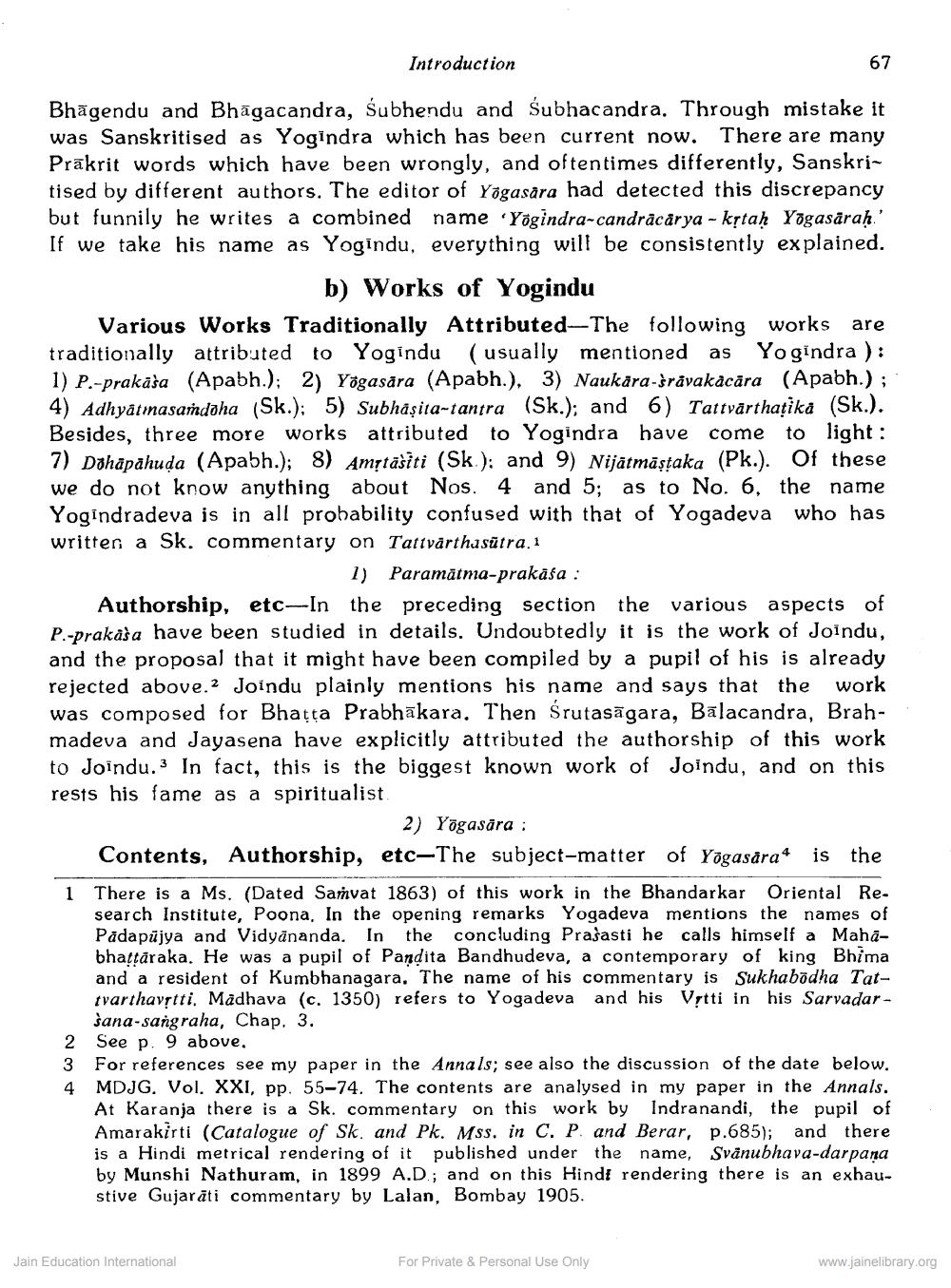________________
67
Bhāgendu and Bhagacandra, Subhendu and Subhacandra. Through mistake it was Sanskritised as Yogindra which has been current now. There are many Prakrit words which have been wrongly, and oftentimes differently, Sanskritised by different authors. The editor of Yagasara had detected this discrepancy but funnily he writes a combined name 'Yogindra-candracarya-kṛtaḥ Yogasāraḥ.' If we take his name as Yogindu, everything will be consistently explained.
Introduction
b) Works of Yogindu
Various Works Traditionally Attributed-The following works traditionally attributed to Yogindu (usually mentioned as Yogindra): 1) P.-prakasa (Apabh.); 2) Yagasara (Apabh.). 3) Naukara-àravakacāra (Apabh.); 4) Adhyatmasamdoha (Sk.): 5) Subhasita-tantra (Sk.); and 6) Tattvarthatika (Sk.). Besides, three more works attributed to Yogindra have come to light: 7) Dahapahuda (Apabh.); 8) Amṛtasiti (Sk.); and 9) Nijatmästaka (Pk.). Of these we do not know anything about Nos. 4 and 5; as to No. 6, the name Yogindradeva is in all probability confused with that of Yogadeva who has written a Sk. commentary on Tattvarthasutra, 1
1) Paramatma-prakala:
Authorship, etc-In the preceding section the various aspects of P.-prakala have been studied in details. Undoubtedly it is the work of Joindu, and the proposal that it might have been compiled by a pupil of his is already rejected above. Joindu plainly mentions his name and says that the was composed for Bhatta Prabhakara. Then Śrutasägara, Balacandra, Brahmadeva and Jayasena have explicitly attributed the authorship of this work to Joindu. In fact, this is the biggest known work of Joindu, and on this rests his fame as a spiritualist.
work
are
2) Yogasora:
Contents, Authorship, etc-The subject-matter of Yogasāra is the
Jain Education International
1 There is a Ms. (Dated Samvat 1863) of this work in the Bhandarkar Oriental Research Institute, Poona, In the opening remarks Yogadeva mentions the names of Pādapūjya and Vidyānanda. In the the concluding Prajasti he calls himself a Mahabhaṭaraka. He was a pupil of Pandita Bandhudeva, a contemporary of king Bhima and a resident of Kumbhanagara. The name of his commentary is Sukhabodha Tattvarthavṛtti. Madhava (c. 1350) refers to Yogadeva and his Vṛtti in his Sarvadarsana-sangraha, Chap. 3.
2 See p. 9 above.
3
For references see my paper in the Annals; see also the discussion of the date below. 4 MDJG. Vol. XXI, pp. 55-74. The contents are analysed in my paper in the Annals.
At Karanja there is a Sk. commentary on this work by Indranandi, the pupil of Amarakirti (Catalogue of Sk. and Pk. Mss. in C. P. and Berar, p.685); and there is a Hindi metrical rendering of it published under the name, Svānubhava-darpana by Munshi Nathuram, in 1899 A.D.; and on this Hindi rendering there is an exhaustive Gujarati commentary by Lalan, Bombay 1905.
For Private & Personal Use Only
www.jainelibrary.org




